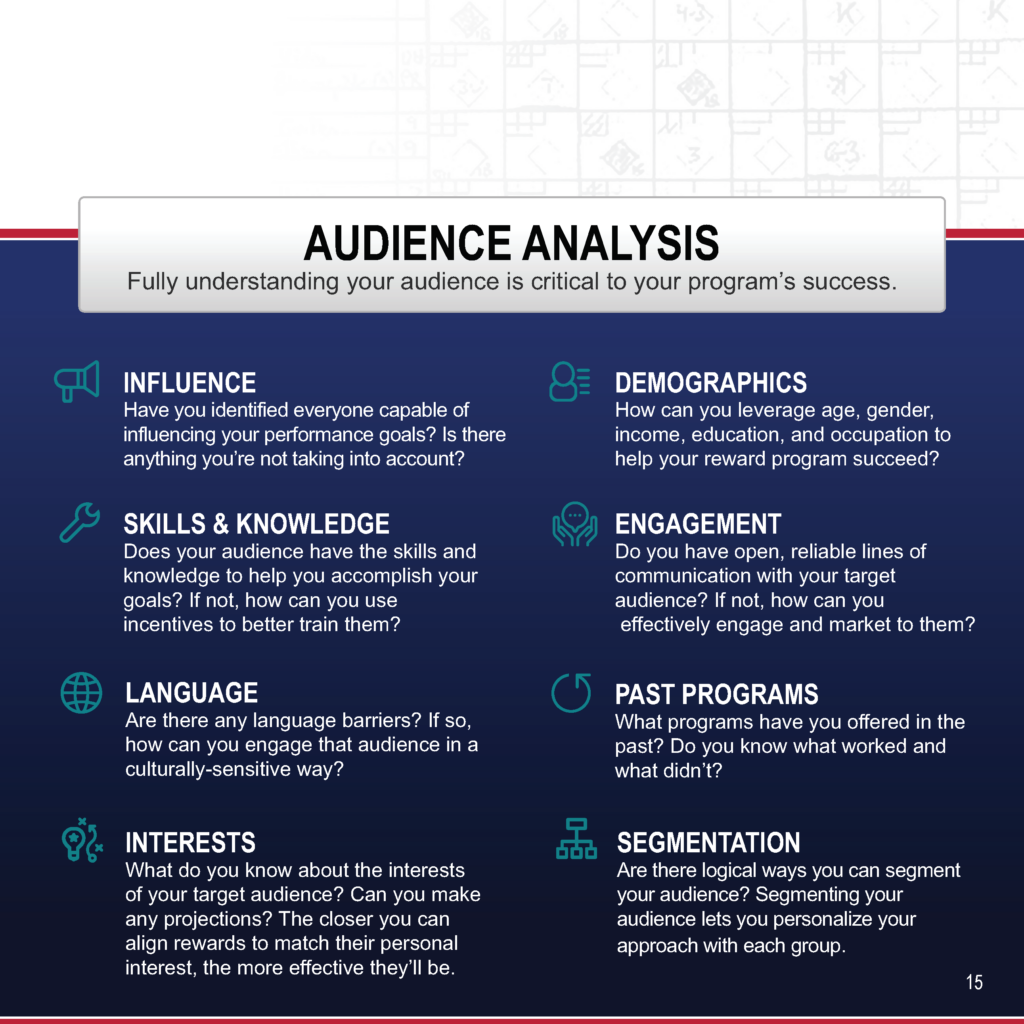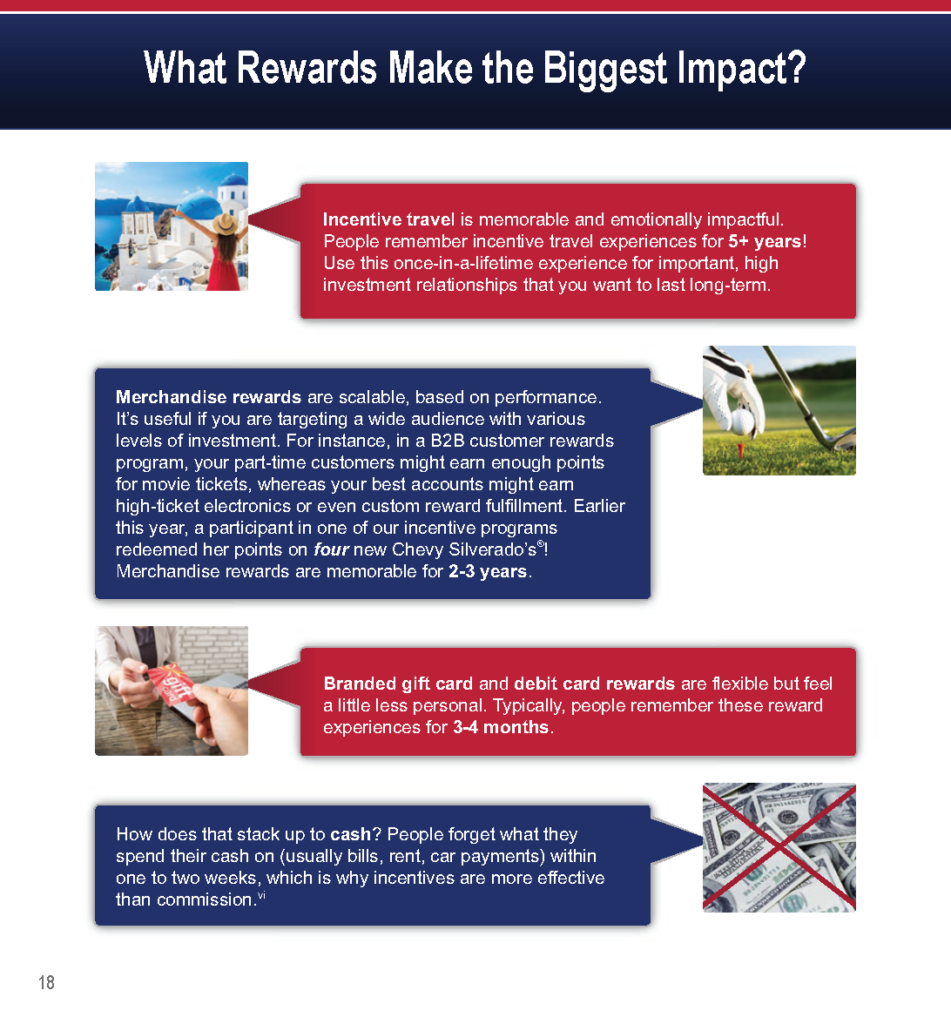Choosing the right incentive rewards for your audience is an important part of an effective incentive program strategy. What factors guide incentive reward selection? Of course, program budget plays a role. However, beyond that, the two most important factors are your target audience and your program goals.
Today we’ll be taking an inside look at pages 15 through 18 of the BtrhuB Incentive Program Playbook (make sure to download your free copy!), which covers audience analysis and reward selection.
Audience Analysis for Your Incentive Program
Your target audience are the people whose behavior you need to influence in order to achieve your incentive program goals. This could be your wholesalers, dealers, internal sales teams, employees, customers, or other channel partners who help you go to market.
Understanding your target audience is critical to your program’s success. After all, in choosing the right incentive rewards, you have to understand what motivates your audience.
How Well Do You Understand Your Target Audience?
Below are several factors you should take into account when analyzing your incentive program audience:

- Influence – Have you identified everyone capable of influencing your incentive program goals? Given your budget, which segment of your audience with produce the highest ROI for your incentive program budget?
- Skills & Knowledge – Does your audience have the skills and knowledge to help you accomplish your goals? If not, how can you use incentives to better train them or provide enablement?
- Language – Are there any language barriers? If so, how can you engage your incentive program audience in a culturally-sensitive way?
- Interests – What do you know about the interests of your target audience? The closer you can align incentive rewards to match their personal interests, the more effective your program will be.
- Demographics – How can you leverage age, gender, income, education, and occupation to help your reward program succeed?
- Engagement – Do you have open, reliable lines of communication with your target audience? If not, how can you effectively engage and market to them?
- Past Programs – What programs have you offered to your audience in the past? What worked and what didn’t?
- Segmentation – Are there logical ways you can segment your audience? Segmenting your audience lets you personalize your approach with each group and get more mileage from your budget.
Choosing the Right Incentive Rewards Based on the 20-60-20 Rule
Are you familiar with the 20-60-20 rule? Basically, it states that 20% of your audience will be top performers – those channel partners and sales reps who consistently go above and beyond. The middle 60% of your audience will be middling performers – who are productive but don’t exactly stand out. Your bottom 20% are the chronic underachievers. This principle is a useful tool in choosing the right incentive rewards.

It’s important that your incentive reward selection scales to each level of performance, based on your goal and your budget. For instance, your top 20% is already performing at a consistently high level. For this segment of your audience, you’ll want to use high end, high investment rewards to build loyalty and retention.
Your middle 60% has the potential to make the biggest difference for your bottom line. Since this segment of your audience is so large, increasing their performance just a little bit can make a major impact. With this segment, your goal is to incentivize growth to inspire them to make the leap to the top 20%, while still building loyalty. Here, scalable, tiered rewards can help impact performance while limiting expenditure.
For your bottom 20%, you don’t want to invest too much, especially at first. But might still be “hidden gems” who have massive potential for growth. For this segment of your target audience, you’ll want to start with low investment rewards that have to potential to scale upwards.
What Incentive Rewards Make the Biggest Impact?
Now that you have a better understanding of your target audience, it’s time to look at the rewards themselves:
- Incentive Travel – Incentive travel is memorable and emotionally impactful. People remember incentive travel experiences for 5+ years! Use this once-in-a-lifetime experience for important, high investment relationships (such as your top 20%) that you want to last long-term.
- Online Rewards – Points-based online rewards are scalable based on performance. These are useful if you are targeting a wide audience with various levels of performance, where you want to provide small investment rewards like movie tickets for your bottom 20%, and high end, custom reward fulfillment for your top performers. Online merchandise rewards are memorable for 2-3 years.
- Gift Card Incentives & Debit Card Rewards – Gift card incentives and debit card rewards are flexible but a little less personal than incentive travel or online rewards. These are useful for the middle 60% and bottom 20% of your target audience, where you are trying to inspire growth. However, card rewards probably won’t be great for a long-term loyalty or customer retention strategy. Typically, people remember these reward experiences for 3-4 months.



